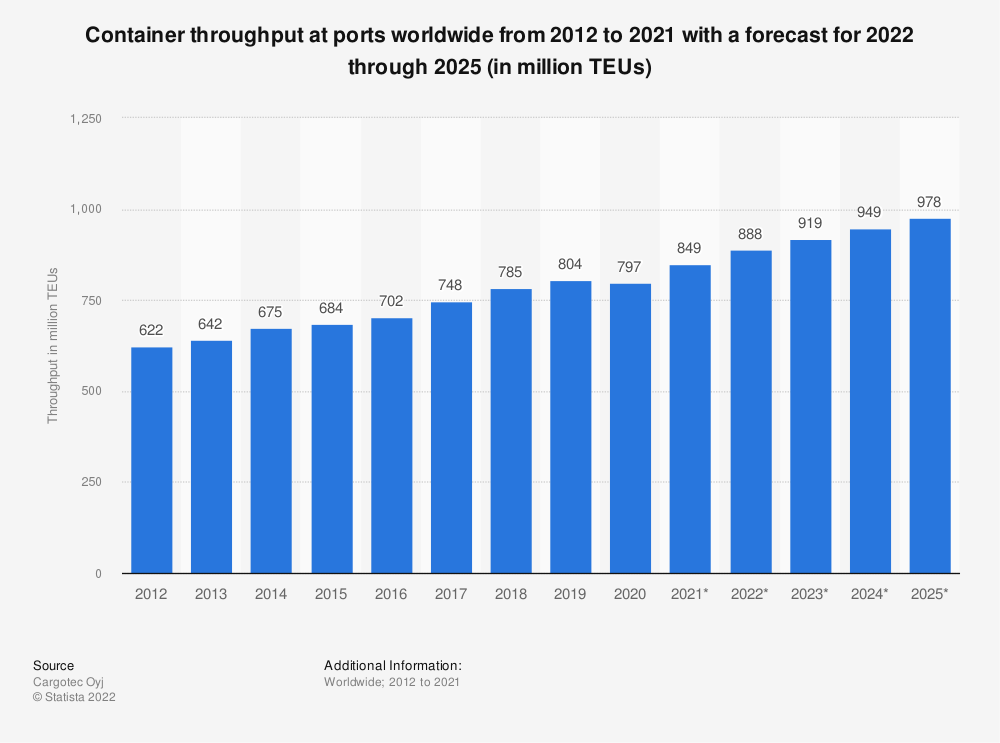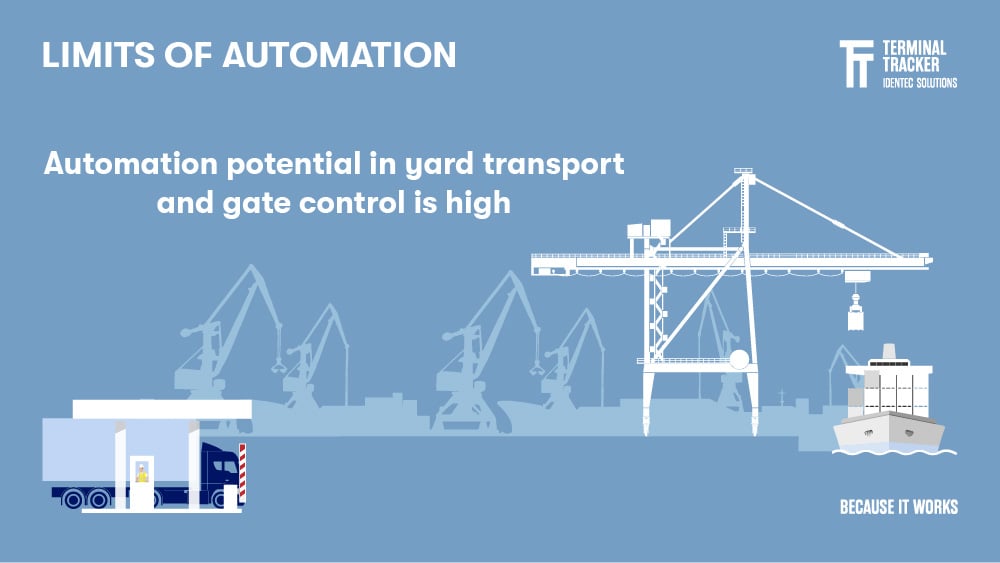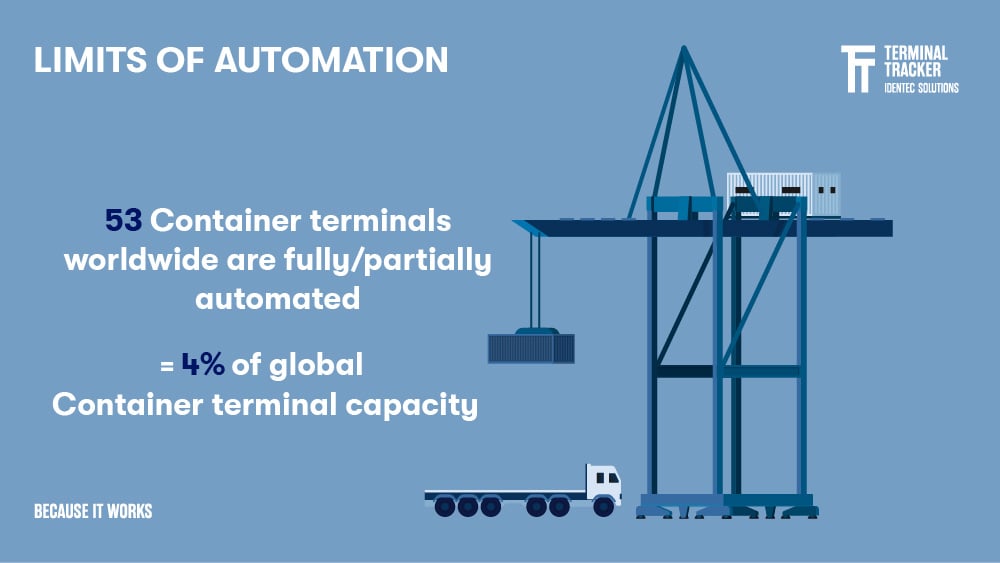Terminal Automation and what to look for
| Written by Mark Buzinkay
Container terminal automation is the application of automated systems to manage the movement of containers within a port or terminal. By design, it improves efficiency and productivity by reducing the time and cost associated with manual handling processes.
After a brief introduction to the shipping industry's history of automation, this whitepaper discusses the potential benefits for container terminals, looks deeper into port processes and uncovers the potential of automation before showing real effects on ports based on use cases rather than models.

No video selected
Select a video type in the sidebar.
Table of contents:
- Automation in the Shipping Industry
- What are the Potential Benefits of Automating Container Terminals?
- Port Processes
- Potential Automation of Terminal Processes
- What are the Effects of Terminal Automation?
- Takeaway
- Glossary
Automation in the Shipping Industry
Since the 1950s, containerisation has been a significant force on maritime transport and has profoundly impacted the shipping industry, enabling large increases in global trade. Containers can be loaded and unloaded rapidly and efficiently, and they can be moved easily between different modes of transport (such as ships, trucks, and trains). In addition, Containerisation eliminated the manual sorting of most shipments and the need for dock-front warehouses. This has significantly reduced the number of dockworkers required to operate a port that formerly handled break bulk cargo. In general, containerisation diminished congestion in ports, significantly shortened shipping time, and reduced losses from damage and theft.
However, containerisation has not led to widespread automation as expected. In 2021, around 53 container terminals were fully or partially automated, accounting for approximately 4% of total container terminal capacity. Nevertheless, about 90% of the current dock work is estimated to disappear by 2040.
There are several reasons why terminal automation has not been more widely adopted. First, it is expensive to install and maintain automated systems. Second, there are concerns about safety and reliability. Third, dockworkers are often resistant to change.
The operational challenges of automating a port are significant. "Nonetheless, successful automated ports show that careful planning and management can surmount these difficulties: operating expenses could fall by 25 to 55 per cent, and productivity could rise by 10 to 35 per cent", says a study from McKinsey (1).
Despite automation's limitations, containerisation has had a major impact on the shipping industry. It has resulted in shorter turnaround times, lower costs, and boosted efficiency. Furthermore, containerisation has been a catalyst for globalisation. Reducing the costs of trade containerisation has motivated specialisation and the expansion of global supply chains.

What are the Potential Benefits of Automating Container Terminals?
Container terminal automation is a relatively new technology designed to improve container handling operations' efficiency and productivity. Automation initiatives suggested improvements in the following areas:
1. Increased efficiency in container handling
Container terminal automation can help boost container handling operations' efficiency by decreasing the time and cost associated with manual processes. This can improve productivity and lower operating costs for port operators.
2. Rationalised cargo handling
Containerisation has rationalised cargo handling and has been credited with significant increases in global trade. In addition, automated container port systems can also improve efficiency by reducing the time and cost associated with manual handling processes.
3. Large increases in global trade
Containerisation has been credited with large increases in global trade. Moreover, automated container port systems can help to increase efficiency and productivity further, leading to even more significant gains in trade.
4. Reduced labour expenditures
One of the key benefits of container port automation is the reduction in labour costs. Automated systems can help reduce manual handling, resulting in lower wages and fewer workers required to operate the port. This can lead to significant cost savings for port operators.
5. Raised safety for workers
Another critical benefit of container terminal automation is the increased safety of workers. Automated systems can help to reduce the risk of accidents and injuries associated with manual handling processes. This contributes to a safer working environment for port workers and improves health and safety outcomes.
6. Increased accuracy and consistency in cargo handling
Another benefit of container terminal automation is better accuracy and consistency in cargo handling. Automated systems can help improve container placement accuracy and reduce cargo damage risk. This can lead to improved outcomes for port operators and shippers.
7. Reduced congestion and pollution at ports
Finally, terminal automation can help to ease congestion and pollution at ports. Automated systems can help to reduce the number of vehicles required to operate the port, leading to fewer emissions and less congestion, creating a more sustainable and efficient port operation.
8. Enhanced Resource Efficiency
Automation can improve the use of energy, water and other resources, thus avoiding waste and improving sustainability. By being as efficient as possible, materials and equipment are conserved, which leads to a longer service life. Space utilisation can also be optimised to achieve better results even without expansions on the available land.

Port Processes
This section reviews the possibilities for container terminal automation. While containerisation has had a transformative effect on global shipping, recent years have seen an increased push for automation to streamline operations further. However, several challenges stand in the way of fully automating container ports. One of the biggest hurdles is the need for human intervention in specific tasks, such as handling damaged containers or dealing with hazardous materials. In addition, the high cost of automation technology is another barrier. But for now, let's look at the port cargo handling process and its potential for automation.
The cargo handling process in container terminals is the set of activities to transfer containers from a ship into the port area onto its next mode of transport and vice versa. Therefore, it is the process from when a ship arrives in port to when the truck (or train, ship, barge etc.) with the container leaves the port, and vice versa. More specifically, from the moment a truck (or train, ship, barge etc.) enters the port area until the container is loaded on the vessel.
Quayside operations
Quayside operations are part of the port cargo handling and consist of the loading and unloading container vessels from ship to shore (or shore to ship). This process can be divided into four sub-processes:
- Lashing
- Operating the quay crane
- Twist-lock handling
- Transferring from the quay to the yard
Lashing
Full container ships transport up to eleven levels of containers on deck and up to nine levels below the deck. These stacked containers are physically connected with twist locks serving as a vertical connection. In addition, containers on deck are attached with lashing bars. When a container vessel moors at a berth, lashers come on board to manually open the twist locks and lashing bars between the individual container layers on deck before the unloading process can begin.
Quay cranes (ship-to-shore cranes) transfer the container from the ship to the quay using a specialised handling tool called the spreader. The spreader locks onto the container's four locking points using the twist-lock mechanism. Quayside operations usually involve several quay cranes at the same time. However, there is a physical limit to the number of quay cranes that can maximally be deployed on container ships, considering the space they take on the quayside. This physical limit acts as a constraint on quayside productivity.
Twist-lock handling
When the container is lifted from the ship, the unlocked twist locks are still attached to the upper container and remain in its lower corner castings. Before onward transport of containers takes place, the twist locks must be withdrawn from the container and returned to the ship after completion of cargo operations. The container is picked up by the quay crane, lifted from the vessel, lowered over the pier and held approximately 1.5 meters above the ground so that lashers can remove the twist locks from the container. After that operation, the container is put down on the ground, picked up by yard vehicles and transported to the container yard (learn more about container yard operations at TTI Algeciras).
Quay-to-yard transport
Transport vehicles transporting containers between quayside and container yard fall into two classes: self-lifting or non-lifting. Non-lifting vehicles need external equipment to load or unload containers, including yard trucks and automated guided vehicles (AGVs). Self-lifting vehicles can lift containers from the ground, either manually or autonomously and include straddle carriers and automated lifting vehicles (ALVs).
Yard operations
Yard operations consist of temporary storage of containers and other assets in areas called container yards. In most terminals, containers spend time in container stacks in the yard before being moved to the hinterland or, before a ship's arrival, a pre-stowage is made at the terminal. Currently, three leading stacking solutions are in use: Straddle carriers (or reach stackers), rail-mounted gantry (RMG) and rubber-tired gantry (RTG). Straddle carriers can move between rows of containers and stack them up to four tiers high. RMGs stack containers in container blocks (stacks) with multiple levels, rows, and bays. RMGs are often automated, in which case they are also called automated stacking cranes (ASCs). RTGs often streamline the movement of containers from one ship to another by orienting containers stacked parallel to the quay.
Read more about Terminal Tracker Position Detection System in Montreal.
Landside operations
Landside operations consist of rerouting containers to or receiving them from a truck, train, barge or ship and covering the transport from the yard to its next transport mode beyond the port gate and vice versa. An essential activity of landside operations besides moving containers from stacks to trucks and trains is checking the containers and trucks entering (and leaving) the port. This check is carried out at the port gate.
The essential data to be identified, checked and transmitted are container number, type, size, condition, weight, owner and voyage-related information. In addition, the container must be identified, and the driver's information, the truck's license number, and the chassis need to be linked with the container. Many container ports have automated a significant part of these gate operations. For example, in many advanced terminals equipped with specially devised devices, truck drivers can swipe their driver's licenses through the window without getting out of the cabin.

Potential Automation of Terminal Processes
The automation potential of quayside operations is very limited: Fixing and removing twist locks is the most challenging process to automate in container terminal handling. The automation of quay crane movements is possible in theory, but quay crane automation is least developed and seldom implemented due to high operational complexity. Furthermore, only horizontal transport from the quay to the yard is considered capable of automation: AGVs and ALVs handle short transport routes guided by different techniques.
Generally, there is consensus that "automated container terminal" usually refers to automated container handling in the yard, in particular use of AGVs, autonomous straddle carriers or autonomous stacking cranes (ASC).
Despite the advantages of port automation, several challenges still need to be addressed. One of the most significant is the lack of standardisation across different automated systems. This can make it difficult for maritime companies to interchange containers between different ports, as they need to ensure that their system is compatible with their destination. Initiatives like TIC4.0 try to overcome this problem by promoting an open standard for container terminal software.
Additionally, the high initial investment in automated systems deters maritime companies from adopting automation.
What are the Effects of Terminal Automation?
Although container port automation faces significant challenges, 4% of all container terminals have already invested in automation and adapted their processes. Therefore, we can use data from these ports to observe the effects of automation in container terminals.
Port performance
It is often assumed that automated ports are more productive. However, automated ports are generally less effective in practice than their conventional counterparts (7-15%, according to McKinsey). Other authors conclude that automation alone cannot be considered to have a highly significant impact on port terminal performance but should always be linked to the general port context to achieve tangible benefits. Port organisation and specialisation, as well as the geographical location and port size, are factors that impact more on the performance of analysed ports rather than simply technology (Ghiara and Tei (2021)).
Another assumption of automating ports is increased reliability (constantly working 24/7 without interruption). In times of Covid-19, strikes and lack of skilled workers, this seems obvious. But various automated container terminals have noticed challenges with malfunctioning automated equipment, resulting in breakdowns, accidents or irrational routing that slowed operations. Concluding, automation provides less flexibility to deal with unexpected circumstances, such as peaks and troughs related to ever-larger container ships.
Handling costs
Automating container terminals generally results in lower labour costs and capital costs, as automated equipment is more expensive than manually operated equipment. If automation projects have been implemented to save costs, then they occurred only in high-wage countries: automation projects make less sense in low-wage countries. However, automated processes need to be designed, supervised and managed, for which staff is still required, often at the same cost as dockworkers or leads to additional hiring costs for specialists.
The introduction of mega-ships on various trade corridors, notably the Asia-Europe corridor, has resulted in more cargo peaks and troughs within the ports along these corridors. Automated ports could make sense in ports with a regular and steady flow of containers, but this is much less the case in ports with volatile and peak-and-trough cargo flows. In those situations, relying on dock labour is more cost-effective, as work can be organised flexibly to meet the irregularity of port cargo flows, especially in ports with labour pools.
Safety and labour conditions
It is often assumed that the safety and health of terminal workers have been improved by automation, and company data suggest reduced accidents in many container terminals over time. However, such high-level data do not distinguish between improvements in operational practices and the extent to which reductions result from fewer dockworkers being exposed to risk due to reduced employment in operational tasks.
Automation in container terminals could lower human errors. Still, automation is also plausible to require greater operation competencies and unlearning old routines and may even lead to new human errors. In addition, several automated ports have been confronted with accidents related to automated equipment.
TAKEAWAY
Terminal automation has had several effects on the maritime industry, particularly regarding the workforce. As automated container handling systems have become more widespread, the need for human dockworkers has decreased. In addition to impacting the workforce, port automation has changed how maritime shipping is conducted. Automated systems have made it possible for ships to unload and load much more quickly than before, which has led to a decrease in turnaround for vessels. This, in turn, has allowed shipping companies to transport goods more efficiently and at a lower cost.
The potential for automation of port processes is significant, but the effects of port automation are less clear. Automation can lead to increased productivity and reliability, but it can also cause new challenges such as accidents and errors. The costs of automated equipment are also generally higher than manual equipment. Ultimately, the decision to automate a port must be made on a case-by-case basis, considering the specific needs and context of the port (learn more about port development at Contecon Guayaquil).
Learn even more about port automation here!
Glossary
An Automated Lifting Vehicle (ALV) is a specialised autonomous vehicle in container terminals capable of independently lifting and transporting containers without requiring additional crane assistance. Unlike standard Automated Guided Vehicles (AGVs), ALVs can self-lift containers from the ground, enhancing operational flexibility and efficiency in yard management and horizontal transportation. (1)
TIC4.0 (Terminal Industry Committee 4.0) is an international non-profit organisation focused on developing standardisation and digitalisation for container terminal operations. Founded in 2018, it brings together terminal operators and equipment manufacturers to create common definitions, performance indicators, and interfaces. The committee aims to facilitate Industry 4.0 technologies, enabling seamless communication and interoperability across port logistics systems. (2)
Sources:
(1) International Transport Forum (2021): Container Port Automation. Impacts and Implications. https://www.itf-oecd.org/sites/default/files/docs/container-port-automation.pdf
(2) Ghiara, H., Tei, A. (2021), Port activity and technical efficiency: determinants and external factors, Maritime Policy & Management, https://doi.org/10.1080/03088839.2021.1872807
(3) McKinsey and Company (1967), Containerization: the key to low-cost transport; London, British Transport Docks Board.
(4) World Bank (2021), “The Container Port Performance Index 2020: A Comparable Assessment of Container Port Performance”, World Bank, Washington DC,
https://www.maritimes.gr/images/PORTS/Container-Port-Performance_Index-WB-2021.pdf?_t=1620669079
(6) Container Terminal Automation Technologies by Michael Rodriguez, Springer, 2024
(7) Port Digitalization and Industry 4.0 by Michael Rodriguez, Springer, 2024
Note: This article was updated on the 6th of August 2025. This article was partly created with the assistance of artificial intelligence to support drafting.

Author
Mark Buzinkay, Head of Marketing
Mark Buzinkay holds a PhD in Virtual Anthropology, a Master in Business Administration (Telecommunications Mgmt), a Master of Science in Information Management and a Master of Arts in History, Sociology and Philosophy. Mark spent most of his professional career developing and creating business ideas - from a marketing, organisational and process point of view. He is fascinated by the digital transformation of industries, especially manufacturing and logistics. Mark writes mainly about Industry 4.0, maritime logistics, process and change management, innovations onshore and offshore, and the digital transformation in general.
Related Articles
Related Product



